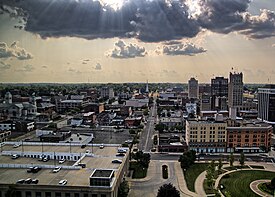
Back جاكسون (ميشيغان) Arabic جاكسون (جاكسون) ARZ جکسون، میشیقان AZB Джексон (Мичиган) CE Jackson (kapital sa kondado sa Tinipong Bansa, Michigan) CEB Jackson, Michigan Welsh Jackson DAG Jackson (Michigan) German Jackson (Míchigan) Spanish Jackson (Michigan) Basque
Jackson, Michigan | |
|---|---|
 Downtown Jackson from the 12th floor of One Energy Plaza (CMS Energy headquarters) | |
| Nickname: The Rose City[1] | |
 Location within Jackson County | |
| Coordinates: 42°14′39″N 84°24′26″W / 42.24417°N 84.40722°W | |
| Country | United States |
| State | Michigan |
| County | Jackson |
| Founded | 1829 |
| Incorporated |
|
| Government | |
| • Type | Mayor–council |
| • Mayor | Daniel Mahoney |
| • Manager | Jonathan Greene |
| • Clerk | Andrea Muray |
| Area | |
| • City | 10.96 sq mi (28.38 km2) |
| • Land | 10.84 sq mi (28.07 km2) |
| • Water | 0.12 sq mi (0.30 km2) |
| Elevation | 932 ft (284 m) |
| Population (2020) | |
| • City | 31,309 |
| • Density | 2,889/sq mi (1,115.4/km2) |
| • Metro | 160,366 (US: 264th) |
| Time zone | UTC−5 (EST) |
| • Summer (DST) | UTC−4 (EDT) |
| ZIP Codes | 49201–49204 |
| Area code | 517 |
| FIPS code | 26-41420 |
| GNIS feature ID | 0629165[3] |
| Website | www |
Jackson is the only city in, and seat of government of, Jackson County in the U.S. state of Michigan.[4] As of the 2020 census, the city population was 31,309.[5] Located along Interstate 94 and U.S. Route 127, it is approximately 65 miles (105 km) east of Kalamazoo, 75 miles (121 km) west of Detroit and 35 miles (56 km) south of Lansing. Jackson is the core city of the Jackson Metropolitan Statistical Area, which includes all of Jackson County and has a population of 160,248.[6]
Founded in 1829, it was named after President Andrew Jackson. Michigan's first prison, Michigan State Prison (or Jackson State Prison), opened in Jackson in 1838 and remains in operation. For the longest time, the city was known as the "birthplace of the Republican Party" when politicians met in Jackson in 1854 to argue against the expansion of slavery, although the political party now formally recognizes its birthplace as being Ripon, Wisconsin.[7][8] Nevertheless, the Republican Party's earliest history dates back to Jackson and is commemorated by a plaque in the city's Under the Oaks City Park, which has since been visited by numerous Republican presidents.[9]
At the beginning of the twentieth century, Jackson became an early automotive manufacturing center that attracted southerners and immigrants to the city's numerous factories, which saw its population increase significantly.
- ^ "Jackson Rose Festival". Jackson County Rose Festival. 2022. Retrieved May 2, 2020.
- ^ "2020 U.S. Gazetteer Files". United States Census Bureau. Retrieved May 21, 2022.
- ^ "Jackson". Geographic Names Information System. United States Geological Survey, United States Department of the Interior.
- ^ "Find a County". National Association of Counties. Archived from the original on May 31, 2011. Retrieved 2011-06-07.
- ^ "Census - Geography Profile: Jackson city, Michigan". United States Census Bureau. Retrieved January 14, 2023.
- ^ Population of Michigan Regions and Statistical Areas, 2000 and 2010, at www.michigan.gov
- ^ "Republican National Committee no longer lists Jackson as birthplace of Republican Party". MLive. Booth Newspapers. 21 January 2019. Retrieved April 23, 2020.
- ^ History (2020). "Republican Party founded". Retrieved May 2, 2020.
- ^ Jackson County Visitors Bureau (2020). "Birthplace of the Republican Party". Retrieved May 2, 2020.



